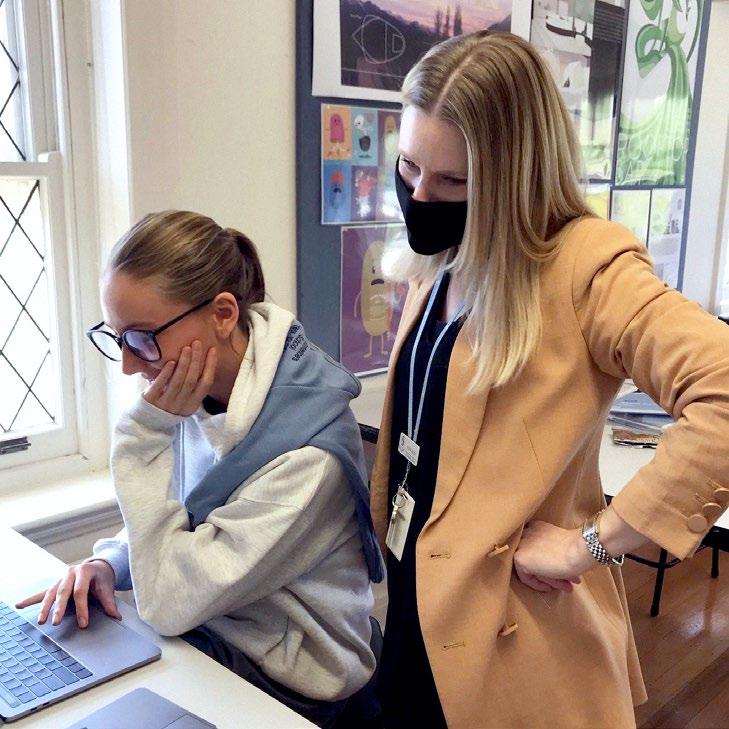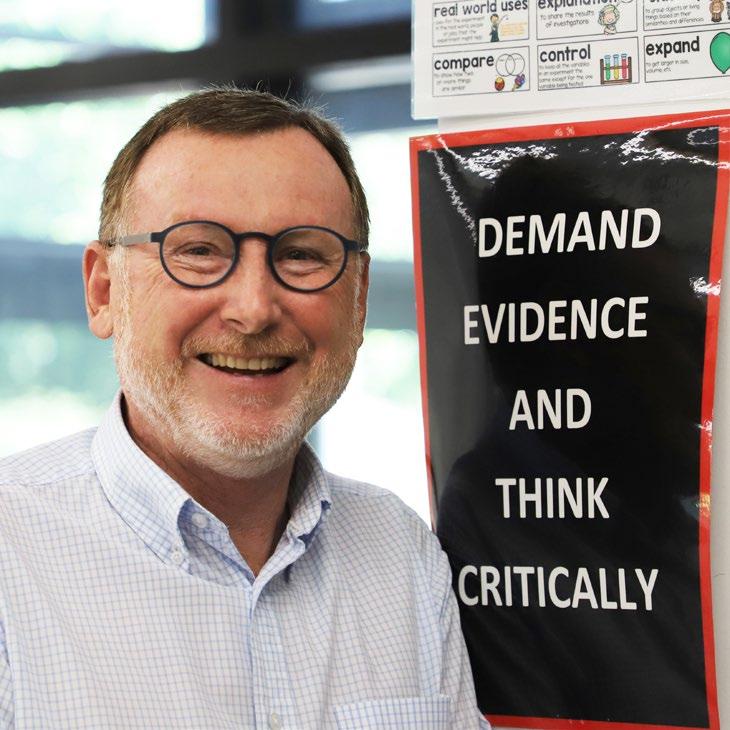
5 minute read
Mr Robert Marshall Academic Extension Challenges Students
Name: Ms Alison Cassidy Title: Visual Communication Design Teacher Date: 22 October 2021 Strategic Intent: Exemplary Staff
IN MY CLASSROOM
This year has once again been turbulent for many of us. It has prompted a revisit to sudden changes in our lives. For me personally, I used the opportunity to extend my professional practice, with the intention of enhancing my students’ learning. Each year I reflect on my teaching and ask myself ‘what does successful classroom pedagogy look like, and have I achieved this’? Most years the response differs slightly, however over the past two years, on reflection, there has been significant growth. The past two years have provided new challenges for every teacher. We have been forced into a whirlwind of online learning without warning, and from this a new phase of teaching has emerged. The teaching model as we currently know it has shifted. Therefore, my teaching pedagogy must do the same. In line with the times, I have re-invented my classroom. Whilst, my classroom has always been far from the ‘traditional’ setting, I constantly challenge myself to explore new and creative teaching tools, now, my classroom is a blend of face-to-face and digital teaching strategies. St Catherine’s School’s Senior Years Learning Model (SYLM) is exemplary in its framework for providing flexible learning models for all students to take control of their learning. In the Visual Arts Faculty, the Masterclasses, and Independent Learning Tutorials within the SYLM are utilised as stepping stones to further students’ learning and provide deeper knowledge of the topics explored. When a student enters my learning space, they have a multitude of options to cater to their individual learning needs. Students receive face-to-face teaching instruction, along with practical demonstrations in conjunction with scaffolded learning through structured steps on the mystcatherines portal. Each unit of work has a combination of written, visual, and video prompts to guide and assist students through their own creative process. The aim is to ensure every student excels in my classroom. Whether you are a visual or sequential learner, I have witnessed success both in student engagement as well as academic achievement through our SYLM framework. Visual Communication Design is a place for students to explore and develop their creativity, critical thinking, and reflectiveness. Students who are independent and willing to step outside their comfort zones thrive within this subject area. My classroom will foster a love of 21st Century teaching styles and nurture in students the skills to navigate their own learning, preparing them for the world and challenges ahead. Whilst COVID has disrupted the world as we knew it, it has also challenged us to reflect and reassess. I am proud that my students, St Catherine’s School, and myself will be better for it.
Ms Alison Cassidy
Visual Communication Design Teacher
Name: Mr Robert Marshall Title: Deputy Principal, Director of Teaching and Learning Date: 29 October 2021 Strategic Intent: Academic Achievement

ACADEMIC EXTENSION CHALLENGES STUDENTS
Designing and implementing a school learning program which caters to the needs and interests of all students is a challenging exercise. Learning is not a process where ‘one size fits all.’ At St Catherine’s our students come from a variety of backgrounds and have an equal variety of interests inside and outside the classroom. Our teachers are experts at developing learning programs which are interesting, engaging and will stimulate the intellectual curiosity of our girls. However, ensuring this always occurs, for all students, is quite a stretch, even for our team of highly talented and skilled teachers. It is well known in education circles and indeed ask any parent, that boredom for a bright teenager is a very real and common experience. The most academically able students can often feel a lack of challenge, disengagement from a class, and downright boredom, when the learning being asked of them is too easy and lacking the right challenge and /or complexity. When a task is pitched at just the right level of challenge, we often refer to this as the Zone of Proximal Development (ZPD). This was first described by renowned psychologist Lev Vygotsky. Put simply, the ZPD refers to the “difference between what a learner can do without help and what he or she can achieve with guidance and encouragement from a skilled partner.” For our high achieving students, a regular class may at times, fail to match their ZPD. In my previous Blue-Ribbon article Being in the Zone, I wrote about the concept of flow, developed by Mihaly Csikszentmihalyi. It is a state of mind in which a person becomes fully immersed in an activity. The activity needs to be at just the right level of challenge or complexity relative to the skill or ability level of the participant. The diagram above demonstrates the concept. The educational implications of this are clear. Provide learning experiences which are too hard, the learner will not cope. Provide opportunities which are too easy, and boredom will soon appear. For a learner to be in a state of flow or in the ZPD, the task needs to match a learner’s ability with the set task or challenge. Not too hard, not too easy, it must be just right. It might be described as a Goldilocks zone. At St Catherine’s, we want to ensure all our students are provided with learning opportunities which stretch and challenge their thinking. In Years 7 and 8 we have developed the Honours Program which caters specifically to a select group of our high achieving academic students. A small group of students are selected, based on academic performance and results of benchmark testing. Students can be invited to attend Honours classes each week in one of English, Humanities, Science and Mathematics classes. The program takes students beyond the normal classroom curriculum and challenges them with more demanding and intellectually enriching material designed to stretch their thinking. This year for example, the Year 7 students in Science Honours, have been studying Hooke’s Law (Fs = -kx for the scientifically minded) which examines the theory of elasticity. Classes have examined this concept and the teacher, set the task of constructing a catapult and performing experiments, including examination of acceleration and how varying surface area affects the flight of a paper plane. Pushing the girls’ thinking to an even deeper level, the class analysed their results using techniques that are vital at VCE, such as data tables and graphing in Excel. With guidance from Mr Brown, the girls were able to find the gradient of a graph, find the R2 values to evaluate how good their data was and examine trendlines, again useful skills at VCE level. Not the usual Year 7 Science subject matter at all.










